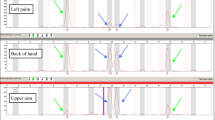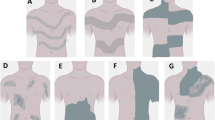Abstract
Humans constantly lose epithelial cells, and these biological traces are frequently studied in the context of criminal investigations. The objective of this work was to examine the genetic profile in samples of forensic interest (nail and skin epithelial cells) of bone marrow transplant patients and discuss its forensic and clinical implications. The genetic profile of nail, epidermal cells and blood samples of patients receiving HSCT was analyzed by the amplification and sequencing of 38 insertion/deletion polymorphisms and 15 short tandem repeat polymorphisms. In this analysis, the age of patients and donors, the time elapsed from the transplant, the type of conditioning prior to the transplant and whether the patient suffered graft-versus-host disease were considered. Donor chimerism can be detected in the DNA extracted from nail and skin epithelial cells of transplant patients. No statistically significant correlation was found between the type of conditioning and the percentage of donor DNA in nail (p > 0.05). A positive correlation, without statistical significance, was encountered when we analyzed the relationship between the time elapsed from the transplant with the percent donor chimerism found in epithelial cells of the epidermis and in nails. We conclude that within a judicial context (e.g. when testifying as an expert witness) it is necessary to consider whether we are facing a possible transplant patient or a person who has been a bone marrow donor.



Similar content being viewed by others
References
Santurtún A, Riancho JA, Arozamena J, López-Duarte M, Zarrabeitia MT. Indel analysis by droplet digital PCR: a sensitive method for DNA mixture detection and chimerism analysis. Int J Legal Med. 2017;131:67.
Castella V, Lesta Mdel M, Mangin P. One person with two DNA profiles: another case of mosaicism or chimerism. Int J Legal Med. 2009;123:427–30.
Li YT, Xie MK, Wu J. DNA profiling in peripheral blood, buccal swabs, hair follicles and semen from a patient following allogeneic hematopoietic stem cells transplantation. Biomed Rep. 2014;2:804–8.
Zhou Y, Li S, Zhou J, Wang L, Song X, Lu X, et al. DNA profiling in blood, buccal swabs and hair follicles of patients after allogeneic peripheral blood stem cells transplantation. Leg Med (Tokyo). 2011;13:47–51.
Santurtún A, Riancho JA, Santurtún M, Richard C, Colorado MM, García Unzueta M, et al. Genetic DNA profile in urine and hair follicles from patients who have undergone allogeneic hematopoietic stem cell transplantation. Sci Justice. 2017;57:336–40.
Pereira R, Gusmão L. Capillary electrophoresis of 38 noncoding biallelic mini-Indels for degraded samples and as complementary tool in paternity testing. Methods Mol Biol. 2012;830:141–57.
Goodwin W, Linacre A, Hadi S. An introduction to forensic genetics. United Kingdom: Wiley; 2007.
Hebda LM, Doran AE, Foran DR. Collecting and analyzing DNA evidence from fingernails: a comparative study. J Forensic Sci. 2014;59:1343–50.
Allouche M, Hamdoum M, Mangin P, Castella V. Genetic identification of decomposed cadavers using nails as DNA source. Forensic Sci Int Genet. 2008;3:46–9.
Bengtsson CF, Olsen ME, Brandt LØ, Bertelsen MF, Willerslev E, Tobin DJ, et al. DNA from keratinous tissue. Part I: hair and nail. Ann Anat. 2012;194:17–25.
Santurtún A, Riancho JA, Yañez L, Santurtún M, Zarrabeitia MT. Analysis of post-transplant chimerism by using a single amplification reaction of 38 Indel polymorphic loci. Bone Marrow Transplant. 2014;49:1432–5.
Sellheyer K. Nail stem cells. J Dtsch Dermatol Ges. 2013;11:235–9.
Acknowledgements
We would like to thank Carmen García for her help in collecting the samples, and all the patients who collaborated with our study to make this work possible.
Author information
Authors and Affiliations
Corresponding author
Ethics declarations
Conflict of interest
The authors declare that they have no conflict of interest.
Ethical approval
This study was reviewed and approved by the Clinical Research Ethics Committee of Cantabria.
Informed consent
All research participants gave their written consent to participate in the study.
Rights and permissions
About this article
Cite this article
Sanz-Piña, E., Santurtún, A., Freire, J. et al. The genetic profile of bone marrow transplant patients in different samples of forensic interest. Forensic Sci Med Pathol 15, 178–183 (2019). https://doi.org/10.1007/s12024-018-0057-9
Accepted:
Published:
Issue Date:
DOI: https://doi.org/10.1007/s12024-018-0057-9




